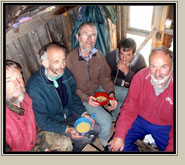 |





 |
 |

 |
DISPATCHES: GREENLAND TO GREENLAND VIA
ICELAND-- JULY 27, 2003
 Apart from a few military bases, nobody lives in northeast
Greenland. So there is essentially no way to get there from anywhere else in
the country. I had to go to Iceland first, and fly back from Iceland, the
embarkation point for all scientific, military and trekking expeditions to
the Northeast Greenland National Park, the largest park in the world.
Apart from a few military bases, nobody lives in northeast
Greenland. So there is essentially no way to get there from anywhere else in
the country. I had to go to Iceland first, and fly back from Iceland, the
embarkation point for all scientific, military and trekking expeditions to
the Northeast Greenland National Park, the largest park in the world.
My destination was Traill Island, where Benoit Sittler, a French scientist,
had invited me to observe his research on lemmings, the smallest mammal, and
only rodent, in Greenland. I arrive in the late evening by Twin Otter
airplane, the primary mode of transportation in the Arctic. The landing
strip is just a flat gravel plateau that has been cleared of boulders and
marked with red flags. Five grizzled men meet me on the landing strip and
show me to my tent. They bring me to a tiny tar-paper shack not much bigger
than a doghouse where they eat meals and socialize. The cabin was built in
the 1930s by fox trappers and abandoned as farm-raised foxes replaced
trapping wild ones. Several years ago a Danish historical society renovated
the dilapidated structure so it is now watertight and keeps most of the
voracious mosquitoes out. Despite the small size, there is room inside
for my five hosts and me to crowd around a tiny wooden box that serves as a
table and to eat dinner.
The following morning, Benoit shows me his research. He has been coming here
to study lemmings for about two months each summer for 16 years. This year,
in more than a month on the island, neither he nor any of his assistants
have seen a single lemming. Most researchers would be disappointed, if not
downright distraught if the object of their research had disappeared. But
Benoit takes it in stride, since the very essence of his study is why
lemming populations fluctuate so dramatically from year to year.
After showing me some abandoned lemming nests, we set out to see the sights.
First we skirt a steep cliff of black stone on a gravel embankment. The
gravel is part of a huge plain of pebbles. In the spring, when the snow is
melting, a powerful torrent rages here. But all that is here now is a
shallow stream. Benoit points to some polar-bear tracks in some mud, which
he believes were made by one of two bears that passed through his camp just
a couple days earlier. After several hours walking we reach a little
red cabin, stocked with food and emergency supplies. This hut is used by the
Sirius Sledge Patrol, the Danish military police that patrols the park by
sled dog in the winter.
On our return to base camp, we stop on a promontory overlooking an island,
about the size of a town common. Several weeks ago the researchers
discovered an unfortunate musk ox that neglected to join inland herds when
the sea-ice bridging the rocky speck to much larger Traill Island melted
away. The animal is unable, or unwilling to swim ashore. Lying there on the
ground as we watch, the beast reminds me of The Little Prince and his small
asteroid. The researchers suspect the animal has eaten everything there is
to consume and will die shortly of starvation.
Later, over a dinner of instant soup, reconstituted potatoes and creamed
sorrel leaves, the discussion turns to the musk ox. Various schemes are
suggested for rescuing the unfortunate beast, such as building a raft of oil
drums. One by one we depart for our tents, carrying flare guns for
protection, in case a polar bear makes a visit. It is midnight. The sun has
disappeared behind the mountains and the sky is dim.
 |
 |

 |
 |

 |
 |
Traill Island
Meet the research team at Traill Island in Greenland and see photos including remains of musk ox and polar bear tracks.
|
 |

 |
 |
Lemmings
See photos of the scatalogical remains lemmings in Greenland.
|
 |
|
 |
|
 |
 |
Vikings | Inuit
| Wildlife
| Ice Cores
| Dispatches
| Teacher
Guides | Credits
© Copyright 2003, WBUR
|
| |
|
 |
|











